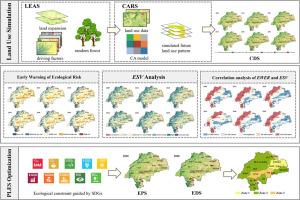基于生态风险预警的干旱半干旱区未来发展多情景空间优化
IF 3.2
3区 环境科学与生态学
Q2 ECOLOGY
引用次数: 0
摘要
人类活动极大地改变了土地利用方式,导致生态风险增加,特别是在生态脆弱的干旱和半干旱地区。以西辽河流域为例,建立了新的生态风险预警框架,并对不同情景下的生态风险进行了预测,以保障生态安全,增强生态系统服务能力。2000 - 2020年,森林和草地面积增加,流域整体环境质量得到改善,生态风险降低。然而,在目前的发展趋势情景下,从2030年到2050年,生活空间的扩大将增加生态风险。生态优先情景提供了更强的环境保护,表明在人口密度高、生态系统脆弱的地区,生态效益最大化至关重要。这种经济发展情景虽然更适合生态稳定和经济繁荣的地区,但可以刺激当地经济增长。与目前的发展趋势相比,生态优先和经济发展方案对生态风险的控制都优于当前的发展趋势。适当战略的选择应根据每个区域的独特特点进行调整。研究结果为空间优化和生态风险科学管理提供了新的视角。本文章由计算机程序翻译,如有差异,请以英文原文为准。

Multi-scenario spatial optimization for future development in arid and semi-arid regions based on early warning of ecological risk
Human activities have significantly transformed land use, resulting in increasing ecological risks, especially in ecologically fragile arid and semi-arid regions. We developed a new early warning of ecological risk framework and predicted ecological risk under different scenarios, aimed at ensuring ecological security and enhancing ecosystem service delivery in regions such as China’s West Liao River Basin. From 2000 to 2020, the areas of forest and grassland space increased, which improved the overall environmental quality of the basin and decreased the ecological risk. However, from 2030 to 2050 under the current development trend scenario, the expansion of living space will increase the ecological risk. The ecological priority scenario offers enhanced environmental protection, suggesting that regions with high population density and fragile ecosystems where maximizing ecological benefits is critical. The economic development scenario, while more appropriate for regions that are ecologically stable and economically prosperous, can stimulate local economic growth. Both the ecological priority and economic development scenarios demonstrate superior control over ecological risk compared to the current development trend. The selection of appropriate strategies should be tailored to the unique characteristics of each region. Our results provide a new perspective for optimizing space and scientifically managing ecological risks.
求助全文
通过发布文献求助,成功后即可免费获取论文全文。
去求助
来源期刊

Ecological Modelling
环境科学-生态学
CiteScore
5.60
自引率
6.50%
发文量
259
审稿时长
69 days
期刊介绍:
The journal is concerned with the use of mathematical models and systems analysis for the description of ecological processes and for the sustainable management of resources. Human activity and well-being are dependent on and integrated with the functioning of ecosystems and the services they provide. We aim to understand these basic ecosystem functions using mathematical and conceptual modelling, systems analysis, thermodynamics, computer simulations, and ecological theory. This leads to a preference for process-based models embedded in theory with explicit causative agents as opposed to strictly statistical or correlative descriptions. These modelling methods can be applied to a wide spectrum of issues ranging from basic ecology to human ecology to socio-ecological systems. The journal welcomes research articles, short communications, review articles, letters to the editor, book reviews, and other communications. The journal also supports the activities of the [International Society of Ecological Modelling (ISEM)](http://www.isemna.org/).
 求助内容:
求助内容: 应助结果提醒方式:
应助结果提醒方式:


